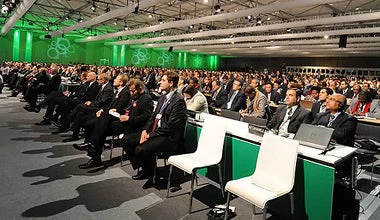
Scientists have been warning for years that a warming planet will bring increasingly extreme and devastating weather. Scientific certainty has brought climate change over the planning horizon, and the impact is now unfurling before our eyes. This level of damage, with millions of people affected, will become more frequent unless we do something about it – fast.
Negotiators from around the world are here in Warsaw for the UN climate conference to work on drivers that can spur that action on a global scale.
It is not overly complicated. We need to get the prices right, get finance flowing, and work where it matters most. But, each of these will take political will to right-size our collective ambition – for ourselves and for the people of the Philippines and the Pacific Islands and the low-lying coasts of Africa and the Caribbean who are directly in harm’s way.
The investment needs for greener, low-carbon growth are substantial, especially in the fast-growing cities of developing countries. It is vital that finance flows to build low-carbon, climate-resilient infrastructure that can stand up to more extreme weather and climate impacts. We must mobilize investment for projects that will improve livability and lower greenhouse gas emissions, such as low-carbon transport, energy efficient buildings and clean energy.
Public money alone will never be enough to meet these needs, but public funding can play two critical roles: first, in crowding in private investments, and, second, in going to places and investing in projects that the private sector will not do alone.
Several climate funds are already proving climate finance, showing how these roles can work, and innovating as they go. The Climate Investment Funds (CIFs), for example, have committed $7.6 billion for 48 countries and leveraged almost $50 billion in investment from other sources, demonstrating how minimum concessional finance can catalyze transformational climate investments. The World Bank Group is in the process of designing a pay-for-performance auction facility for methane reduction that will test approaches for mobilizing finance, including using auctions to allocate its resources, with the potential for to scale across mitigation finance. The multilateral development banks have also harmonized a framework to track and report climate finance and provide increasing transparency on finance flows and have agreed shared guidelines on deploying concessional funds to the private sector.
The success of the climate negotiations rests heavily on climate finance pledges coming through and finance flowing to where it is needed most. We know that public climate finance is precious, not only as a signal of commitment to the UN Framework Convention on Climate Change and to the common cause the UNFCCC stands for, but also because it will be produced at a time of economic hardship in many of the countries that will provide it, and, importantly, because it can be used flexibly to do things that other finance may not do.
Public finance can maximize the mobilization of other forms of finance through the astute development of the Green Climate Fund and through the use of the balance sheets, organizational capacity, and technical knowledge of the multilateral development banks and bilateral development financial institutions. The prize – the leveraging of institutional investors, sovereign funds, and pension funds, climate capital markets, and others – has proven difficult at a time when global financial markets retreat from risk. But by matching the specific financial fiduciary and risk/reward needs of investors with projects and project portfolios, and using public climate finance to develop new products and test their introduction, we can do this. Certainly at the World Bank Group, we will redouble our efforts.
But, while we can use climate finance smartly, governments will also need to send clear policy signals to redirect foreign and domestic investment into green and inclusive growth and low-carbon development. A robust price on carbon and moving away from harmful fossil fuel subsidies that do little to efficiently protect the vulnerable from price shocks are two important steps. Also important are supervision and regulations that supports investment in clean and resilient development and raise questions about the wisdom of long-term investments in a carbon-intense economy.
As we try, with others, to support efforts to speed and scale mitigation action and investment in resilience, we will need a disciplined focus on getting prices right, getting finance flowing, and investing where it matters most.
Rachel Kyte
Vice President for Sustainable Development
www.worldbank.org/sustainabledevelopment
Twitter: @rkyte365
Photo: The UN Climate Conference opens in Warsaw. Credit: UNClimateChange


Join the Conversation